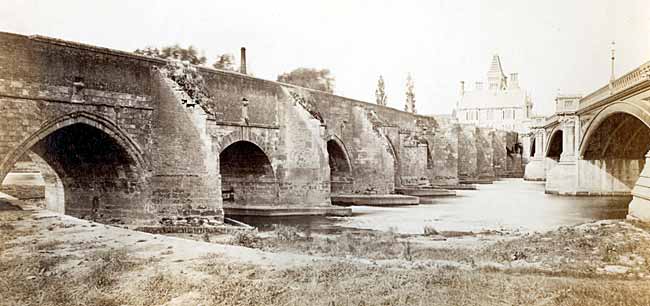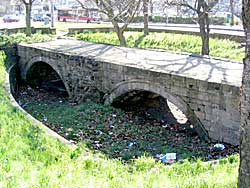< Previous | Contents | Next >
During the civil wars between Charles and his parliament it was captured, in 1644, by the Newarkers who slew seventeen of the Nottingham men forming its garrison and after the cessation of hostilities it was, in 1683, very much damaged and a considerable portion carried away by a flood. It was repaired and at this time was six hundred and sixty eight feet long by about twenty feet wide, and was carried upon fifteen arches. In 1725 it was again repaired, and a toll house was set up, and although the right of the Corporation to levy toll was contested, it was upheld by the courts of law. In 1840 Queen Victoria and Prince Consort passed over Heth Beth Bridge in their progress from Nottingham railway station to Belvoir Castle, which accounts for the Royal Arms being displayed upon the present bridge in memory of that occasion. But the time was approaching when the old bridge which was now carried upon seventeen arches, proved to be utterly inadequate for the work it had to do, and in 1853 Sir William Cubbit prepared plans for a new bridge. However, nothing was done and traffic struggled along until 1871 when the magnificent Trent Bridge, designed by Mr. Tarbotton, the borough engineer, and erected at a cost of £30,000 was opened by Alderman Manning. It is amusing, in light of later experience, to record that Alderman Manning and his colleagues had to put up with considerable criticism because they erected a bridge which their contemporaries considered was far too wide for any traffic it would ever have to carry. Fifty-five years later in 1926 it has been found necessary to almost double the width of Trent Bridge.

Both Trent Bridges in 1871.
It is a curious colloquialism that Trent Bridge is so frequently referred to as "The Bridges." There are two explanations of this curious phrase, neither of which are very convincing, but which I give for what they are worth. The first of them is that for some months the Old and the New Trent Bridge were standing side by side, and the spectacle of the two bridges so impressed our forefathers that the term "The Bridges" became embedded in local language. The other explanation is that a hundred yards or so to the north of the river there was a hollow cut by some older bed of the river which was crossed by a further set of arches, and so the two bridges became referred to as "The Bridges" a name which has stuck, even though the northern set of arches has now disappeared.

Remnants of the old Trent Bridge (A Nicholson, 2004).
Of the mediaeval bridge there is still an arch dated about 1364, left close to the police station on the Bridgford side of the river. This carries an asphalt path which serves as an approach to "Lovers Walk" and is an interesting memorial of the long and complicated history of Trent Bridge.
At the northern end of Trent Bridge, about on the site now occupied by the Town Arms Hotel, stood the old water works of Nottingham, which were such a charming feature of the landscape forty or fifty years ago, but which have now completely disappeared. A tall brick chimney, mellowed from its first rawness by age, and a grove of well-grown trees marked the old pumping station. There was a great settling tank, or reservoir, receiving water from the river Trent, which reservoir occupied both sides of the road, and a faint echo of which remains in the gardens between Messrs. Turney's works and the river. After this water had passed the filter-bed it was pumped to the reservoir on the eastern side at the upper end of Park Row. For many years this reservoir was open, and surrounded by trees, and was an extremely picturesque object, but some forty or fifty years ago it was covered over by a great concrete roof, which has remained until 1925, when it was broken with considerable difficulty, and the site devoted to the erection of an out-patients' department for the Nottingham General Hospital. These waterworks at Trent Bridge and also the reservoir on Park Row, were erected in 1831, and we are informed that the water was forced through the mains from Trent Bridge by an engine of forty horse power, at the rate of ten hogsheads per minute. The reservoir is a hundred and thirty feet above the Trent, and in 1850 the water distributed from it through about twelve miles of pipe to the neighbouring districts.
The whole apparatus was taken over in 1880 by the Corporation, and although in good working order, it was immediately put out of commission and pulled down, for it was superseded by the modern and excellent water supply of Nottingham.
The story of Nottingham's water supply is both curious and interesting, and these old Trent Bridge water works fill a very important page of that history. Of course the primitive system of obtaining water was from wells or from the river, and about it as far as Nottingham is concerned we know very little indeed, although here and there throughout the city we keep coming across the remains of old wells. In 1696, two years after the Bank of England was established, powers were taken to supply Nottingham with water and a Waterworks Company was formed. This company took water from the river Leen at the Castle rock, and it was pumped by means of an hydraulic engine, which was housed at the foot of Finkhill Street to a reservoir on the east side of Park Row, whose site is now occupied by an extension of the General Hospital. This reservoir was made out of a section of the old town ditch, and from it water was distributed in pipes to the neighbourhood. The company later took a lease of the old fishpond of Nottingham Castle, whose site is now built over and Hope Drive and Fishpond Drive formed on it. This fishpond gradually silted up and in 1791 it was used as a dump for the soil taken out in preparing for the erection of the barracks at the end of Barrack Lane on the upper side of the Park. Owing to the decayed vegetable matter mixed with this soil the neighbourhood became very fertile. It was turned into gardens and the Fishpond Gardens, as they were called, obtained more than a local celebrity for the beauty of their flowers and the excellence of their vegetables.
In about the thirties of last century many complaints were made as to the quality of the water the company were supplying and this is hardly to be wondered at seeing that they were drawing it direct from the Leen which was acting as a general sewer for all the villages in the Leen Valley, and it does not appear to have been filtered in any way whatever. To provide against this contamination the Water Company established new works at Scotholme near Basford, taking the water from the river nearer its source. This water they piped along by the side of the Leen in nine-inch iron pipes to the bottom of the Castle Rock. They erected a new engine house in Brewhouse Yard, the site at present occupied by the Corporation Water Department, and pumped this new supply of water up to their old reservoir underneath the present hospital.
In addition to this undertaking the Corporation had in their hands an establishment which was called the Northern Water Works, founded in 1826. It was situated in Sherwood Street next door to the Jews Cemetery and faint indications of it may still be seen. Water was pumped from a spring into a cistern and from it distributed to the upper part of Mansfield Road. The spring ceased to flow about 1870, and the site is now built over. Then again, Messrs. George Beardmore & Sons had a water supply on Zion Hill. They pumped water from springs underneath Zion Hill and Holden Street from a well sixty yards deep to a reservoir on the top of their engine house from which they distributed it to the barracks, Radford and Park Side. They sold their undertaking to Messrs. Walker and eventually the Water Company paid Messrs. Walker no less a sum than £5,000 to terminate the supply. Another similar local supply was from wells behind the "Hand and Heart," Derby Road. But this was a very much smaller undertaking and does not appear to have been bought out by the Water Company. In addition to all these supplies of water which of course could only be obtained by customers who were prepared to pay for a supply, there were no less than twenty-two public wells and pumps through the town in addition to scores of private wells and finally water carts which were supplied with water from the Northern Water Works used to perambulate the town selling water at a halfpenny per bucket. Folk had strange whims as to their favourite spring. Some springs or wells were considered better for making tea while others were preferred for brewing and others for washing purposes, so that folk were quite prepared to keep "vintages" as it were, of water for different purposes. In addition to all this there were several medicinal springs in the town as for example the spring at St. Anne's Well, or most noticeable of all, the chalybeate spring in Spa Close, just about where the Byard Manufacturing Company premises now stand on Castle Boulevard. This spring was much sought after at one time and was regarded locally as an excellent substitute for the waters of the great medicinal Spa's of Buxton, Bath and elsewhere.
